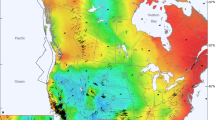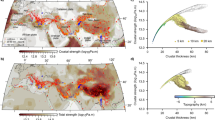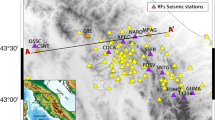Abstract
The factors that control the flexural rigidity — or effective elastic thickness (EET) — of continental lithosphere have been extensively studied over the past two decades. Using EET estimates derived from the analysis of topography, basin structures and gravity anomalies, several authors1,2,3,4,5 have shown that crustal thickness, geothermal gradient, strain rate, rheology and plate curvature all affect the flexural strength of continents. Recognition that certain combinations of these parameters result in a significant reduction of flexural strength caused by decoupling of the crust and the upper mantle3,5 has been a critical step in understanding why many continental areas have estimated EETs that are thin compared with the total mechanical thickness of the continental lithosphere5. Here we develop a semi-analytical model of the EET through a parametrization of the yield stress envelope6,7 that includes the effects of crust–mantle decoupling. We perform a detailed comparison of EET estimates at foreland basins and mountain belts to values predicted by our model and find that, to predict the EET estimates successfully, we need to take into account the effect of the sediment cover and to use a strong plagioclase-controlled rheology. The effect of sediment cover is to weaken the lithosphere because of the lower density of sediments relative to crystalline crust5,8,9 and by thermally insulating the lower crust9,10,11.
This is a preview of subscription content, access via your institution
Access options
Subscribe to this journal
Receive 51 print issues and online access
$199.00 per year
only $3.90 per issue
Buy this article
- Purchase on Springer Link
- Instant access to full article PDF
Prices may be subject to local taxes which are calculated during checkout



Similar content being viewed by others
Change history
01 April 1998
Nature 389, 476–479 (1997) The last term on the right-hand side of equation (1) should read to make it consistent with an integration over the variable z rather than over the function u(z).
References
Karner, G. D. & Watts, A. B. Gravity anomalies and flexure of the lithosphere at mountain ranges. J.Geophys. Res. 88, 10449–10477 (1983).
Kusznir, N. & Karner, G. D. Dependence of the flexural rigidity of the continental lithosphere on rheology and temperature. Nature 316, 138–142 (1985).
McNutt, M. K., Diament, M. & Kogan, M. G. Variations of elastic plate thickness at continental thrust belts. J. Geophys. Res. 93, 8825–8838 (1988).
Royden, L. H. The tectonic expression slab pull at continental convergent boundaries. Tectonics 12, 303–325 (1993).
Burov, E. G. & Diament, M. The effective elastic thickness of the continental lithosphere: what does it really mean? J. Geophys. Res. 100, 3905–3927 (1995).
Goetze, C. & Evans, B. Stress and temperature in the bending lithosphere as constrained by experimental rock mechanics. Geophys. J. R. Astron. Soc. 59, 463–478 (1979).
Bodine, J. H., Steckler, M. S. & Watts, A. B. Observations of flexure and the rheology of the oceanic lithosphere. J. Geophys. Res. 86, 3695–3707 (1981).
Cloetingh S., Wortel, M. J. R. & Vlaar, N. J. Evolution of passive continental margins and initiation of subduction zones. Nature 297, 139–142 (1982).
Steckler, M. S. & ten Brink, U. S. Lithospheric strength variations as a control on new plate boundaries: examples from the northern Red Sea region. Earth Planet. Sci. Lett. 79, 120–132 (1986).
Karner, G. D. Sediment blanketing and the flexural strength of extended continental lithosphere. Basin Res. 3, 177–185 (1991).
Molnar, P. & Tapponnier, P. Apossible dependence of tectonic strength on the age of the crust in Asia. Earth Planet. Sci. Lett. 52, 107–114 (1981).
Kohlstedt, D. L., Evans, B. & Mackwell, S. J. Strength of the lithosphere: constraints imposed by laboratory experiments. J. Geophys. Res. 100, 17587–17602 (1995).
Kirby, S. H. & Kronenberg, A. K. Rheology of the lithosphere. Rev. Geophys. 25, 1219–1244 (1987).
Zhang, Y.-S. & Tanimoto, T. High-resolution global upper mantle structure and plate tectonics. J.Geophys. Res. 98, 9793–9823 (1993).
Sclater, J. G. & Christie, P. A. F. Continental stretching; an explanation of the post-Mid-Cretaceous subsidence of the central North Sea basin. J. Geophys. Res. 85, 3711–3739 (1980).
Quinlan, G. M. & Beaumont, C. Appalachian thrusting, lithospheric flexure, and the Paleozoic stratigraphy of the Eastern interior of North America. Can. J. Earth Sci. 21, 973–996 (1984).
Stewart, J. & Watts, A. B. Gravity anomalies and spatial variations of flexural rigidity at mountain ranges. J. Geophys. Res. 102, 5327–5353 (1997).
Turcotte, D. L. & Shubert, G. Geodynamics. Applications of Continuum Physics to Geological Problems, 131–133 (Wiley, New York, (1982)).
Snyder, D. B. & Barazangi, M. Deep crustal structure and flexure of the Arabian plate beneath the Zagros collisional mountain belt as inferred from gravity observations. Tectonics 5, 361–373 (1986).
Watts, A. B., Lamb, S. H., Fairhead, J. D. & Dewey, J. F. Lithospheric flexure and bending of the central Andes. Earth Planet. Sci. Lett. 134, 9–21 (1995).
Royden, L. H. & Karner, G. D. Flexure of lithosphere beneath Apennine and Carpathian foredeep basins: evidence for an insufficient topographic load. Am. Ass. Petrol. Geol. Bull. 68, 704–712 (1984).
Macario, A., Malinverno, A. & Haxby, W. F. On the robustness of elastic thickness estimates obtained using the coherence method. J. Geophys. Res. 100, 15163–15172 (1995).
Royden, L. H. & Burchfiel, B. C. Are systematic variations in thrust belt style related to plate boundary processes? (The western Alps versus the Carpathians). Tectonics 8, 51–61 (1989).
Seber, D., Valve, M., Sandvol, E., Steer, D. & Barazangi, M. Middle East Tectonics: applications of Geographic Information Systems (GIS). GSA Today 7(2), 1–6 (1997).
Koop, W. J. & Stoneley, R. Subsidence history of the Middle East Zagros Basin, Permian to Recent. Phil. Trans. R. Soc. Lond.A 305, 149–168 (1982).
Fan, P. & Ma, B. L. Generan Petroleum Geology of the Tarim Basin, Vol. 1, 1–21 (Academia Sinica, Science Press, Beijing, (1990)).
Teng, J. W. Geophysical Fields and Hydrocarbon Prospects of the Tarim Basin, Vol. 2, 24–40 (Academia Sinica, Science Press, Beijing, (1991)).
Verma, R. K. Gravity field and nature of continent–continent collision along the Himalayas. Phys. Chem. Earth 18, 385–403 (1991).
Wigger, J. W. et al. in Tectonics of the Southern Central Andes, Structure and Evolution of an Active Continental Margin (eds Reutter, K.-J., Scheuber, E. & Wigger, P. J.) 23–48 (Springer, Berlin, (1994)).
Dunn, J. F., Hartshorn, K. G. & Hartshorn, P. W. in Petroleum Basins of South America (eds Tankard, A.J., Suárez Soruco, R. & Welsink, H. J.) 523–543 (Am. Ass. Petrol. Geol. Mem. 62, (1995)).
Hinze, W. J. & Braile, L. W. in The Geology of North America, Vol. D-2(Sedimentary Cover–North American Craton: U.S.) 5–24 (Geological Society of America, Boulder, CO, (1988)).
Rankin, D. W. et al. in Centenial Continent/Ocean Transect Vol. E-4 Central Kentucky to Carolina Trough 2 sheets (Geological Society of America, Boulder, CO, (1991)).
Roure, F., Roca, E. & Sassi, W. The Neogene evolution of the outer Carpathian flysch units (Poland, Ukraine and Romania): kinematics of a foreland/fold-and-thrust belt system. Sediment. Geol. 86, 177–201 (1993).
Raileanu, V., Talos, D., Varodin, V. & Stiopol, D. Crustal seismic reflection profiling in Romania on the Urziceni–Mizil line. Tectonophysics 223, 401–409 (1993).
Buness, H. in Joint Interpretation of Geophysical and Geological Data Applied to Lithospheric Studies (eds Giese, P. et al.) 193–215 (Kluwer, Dordrecht, (1991)).
Ori, G. G. Continental depositional systems of the Quaternary of the Po plain (northern Italy). Sediment Geol. 83, 1–14 (1993).
Mueller, S. in Mountain Building Processes (ed. Hsue, K. J.) 181–199 (Academic, London, (1982)).
Khale, H. G., Klingele, E., Mueller, S. & Egloff, R. The variation of crustal thickness across the Swiss Alps based on gravity and explosion seismic data. Pure Appl. Geophys. 114, 479–494 (1976).
Beloussov, V. V. et al. Structure of the lithosphere along the Deep Seismic Sounding profile: Tien Shan–Pamirs–Karakorum–Himalayas. Tectonophysics 70, 193–221 (1980).
Acknowledgements
We thank B. Coakley, C. Ebinger, R. Newman and N. White for constructive comments that improved the paper. We thank the NSF Earth Sciences, and F. Brigaud and Elf-Aquitaine Exploration Production, for support.
Author information
Authors and Affiliations
Corresponding author
Rights and permissions
About this article
Cite this article
Lavier, L., Steckler, M. The effect of sedimentary cover on the flexural strength of continental lithosphere. Nature 389, 476–479 (1997). https://doi.org/10.1038/39004
Received:
Accepted:
Issue Date:
DOI: https://doi.org/10.1038/39004
Comments
By submitting a comment you agree to abide by our Terms and Community Guidelines. If you find something abusive or that does not comply with our terms or guidelines please flag it as inappropriate.



